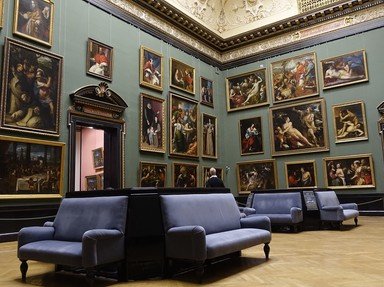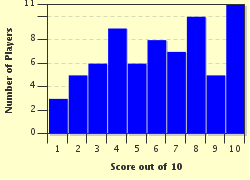Quiz Answer Key and Fun Facts
1. We begin our tour with "The Harvesters", an oil on wood from 1565. One in a series of six works by an artist famous for his 'genre paintings', this has also been described as the first modern landscape. Who is the Netherlandish Renaissance artist?
2. "Cardinal Fernando Nino de Guevara" is a 67"x42" oil on canvas painted around 1600. The artist, a painter, sculptor and architect of the Spanish Renaissance, is particularly known for his tortuously elongated figures, with a style so unique that he does not fit conveniently into any one school. Who is the artist?
3. This 1787 canvas depicts a classical scene: "The Death of Socrates" shows the great philosopher giving a final lesson to his pupils as his execution by hemlock poisoning takes effect. Who is the important French artist from the Neoclassical school?
4. Painted in 1787, "Manuel Osorio Manrique de Zuñiga" depicts the son of the Count and Countess of Altamira outfitted in a splendid red costume. Who is the Spanish Romantic artist who is also known for a number of considerably darker works?
5. This 1835 oil-on-canvas landscape, "The Grand Canal", depicts a scene that has been painted by numerous artists. The Romantic artist who painted this version is as renowned for his watercolour landscapes as for his oils. Sometimes known as "the painter of light", who is this artist?
6. Painted in 1845, "Fur Traders Descending the Missouri" is a work in the style called 'luminism'. Who is the American artist, whose paintings mostly depict life in the frontier lands along the Missouri River?
7. This 1862 painting, "Portrait of Mademoiselle Victorine in the Costume of a Bullfighter", is one of numerous works by this artist in the collection at The Met. One of the earliest artists to paint works depicting modern life, who is this pivotal artist in the transition from Realism to Impressionism?
8. "Still life, Bowl with Apples" is a work from 1878 by an artist whose vast body of work includes portraits, many examples of still life, as well as numerous Impressionist-style landscapes. Who is this artist, often said to be the bridge between Impressionism and the Cubism of the early 2oth century?
9. These two small painted panels known as the "Diptych with Calvary and Last Judgement" date the 1430s. Although probably completed by his followers and members of his workshop, to which Early Netherlandish artist are these panels attributed?
10. We conclude our brief tour of the collection at the Metropolitan Museum of Art in New York City with "The Fortune Teller", a work dating to 1630. This is an unusual painting by an artist more commonly associated with religious compositions notable for emphasis on the use of light. Who is this French Baroque painter?
Source: Author
EnglishJedi
This quiz was reviewed by FunTrivia editor
looney_tunes before going online.
Any errors found in FunTrivia content are routinely corrected through our feedback system.

